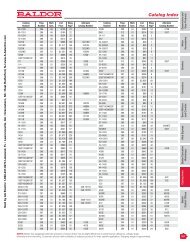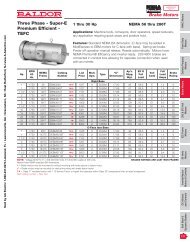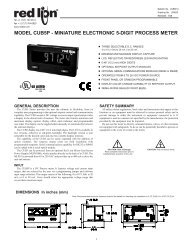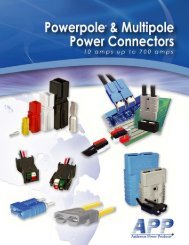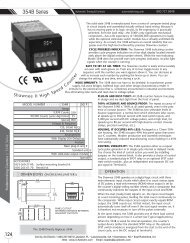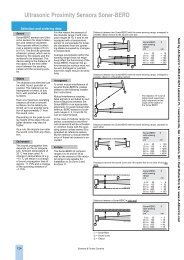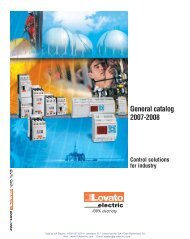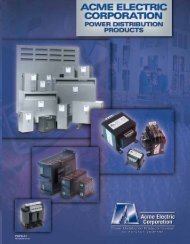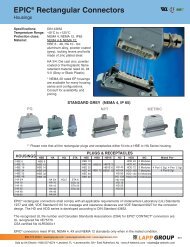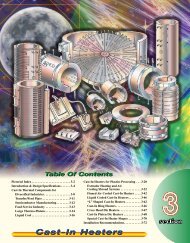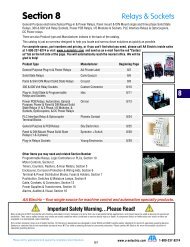Create successful ePaper yourself
Turn your PDF publications into a flip-book with our unique Google optimized e-Paper software.
Technical Reference<br />
ence<br />
Signal Conditioners<br />
While there are many different types of signal conditioners, their basic function<br />
is to change or alter signals so that different process devices can communicate<br />
with each other accurately. Signal conditioners are most commonly needed to<br />
link temperature, pressure, weighing, level, and flow devices with indicators,<br />
recorders, and computerized process monitoring and control systems. Signal<br />
conditioners can also perform some other tasks for you as listed below.<br />
SIGNAL CONVERSION<br />
A signal conditioner can change an analog signal from one form to another<br />
allowing equipment with dissimilar signals to communicate. For instance, if a<br />
piece of field equipment puts out a 4-20 mA signal and the control system needs<br />
a ±10 V input signal, the signal from the field equipment must be converted. A<br />
signal conditioner that accepts a 4-20 mA input and produces a ±10 V output<br />
solves the problem.<br />
SIGNAL BOOSTING<br />
The signal conditioner increases load drive capability in the loop allowing installation<br />
of additional instruments. This works because the input impedance of<br />
most isolators is much less the load drive capability of a loop. Therefore adding<br />
an isolator to the loop boosts the loop’s net load drive capability. This is especially<br />
useful when it becomes necessary to add additional devices to an existing<br />
overloaded loop.<br />
SIGNAL ALARMING<br />
Warns of trouble if a process signal reaches a too high or too low level. A signal<br />
conditioner that accepts an analog signal (4-20 mA, 1-5 V, etc.) and produces a<br />
relay output is an inexpensive way of providing a redundant safety device in the<br />
event of a system failure.<br />
SIGNAL ISOLATION<br />
Stops ground loops from affecting the accuracy of a process signal. Ground<br />
loops are a common complaint at system startup and can be eliminated by<br />
installing isolated signal conditioners, or isolators, on the process loop between<br />
a non-isolated device and a control system.<br />
SPECIFYING<br />
A signal conditioner requires much of the same information as specifying any<br />
other instrument. Always consider these elements:<br />
❑ Power Source<br />
❑ Input Signal<br />
❑ Output Signal<br />
❑ Desired Options<br />
Power System Terminology<br />
Active Power (Watt): Sometime called Real Power, True Power or Effective<br />
power. It describes the actual amount of power present in a system in watts (W)<br />
and the symbol is P. In a simple resistive circuit, the voltage and current are in<br />
phase and the active power is equal to the apparent power.<br />
Ambient Temperature: The temperature of the air, water, or surrounding earth.<br />
Ampacity: The current-carrying capacity of conductors or equipment,<br />
expressed in amperes.<br />
Ampere (A) or amp: The basic SI unit measuring the quantity of electricity. The<br />
unit for electric current or the flow of electrons. One amp is 1 coulomb passing<br />
in one second. One amp is produced by an electric force of 1 volt acting across<br />
a resistance of 1 ohm.<br />
Ampere-hour (Ah): Quantity of electricity or measure of charge. (1 Ah = 3600<br />
Coulomb)<br />
Apparent power (VA): Used to describe the useful or working power in a system.<br />
It is measured in VA volt-amperes (not watts). The symbol is S. It is used to<br />
describe the resultant power due to the phase separation between the voltage<br />
and current. In an alternating current circuit, both the current and voltage are<br />
sinusoidal. The Apparent Power is the useful power in the system by taking into<br />
account the Power Factor.<br />
Ground: A large conducting body (such as the earth) used as a common return<br />
for an electric circuit and as an arbitrary zero of potential.<br />
Impedance: The total opposition that a circuit offers to the flow of alternating<br />
current or any other varying current at a particular frequency.<br />
Inductive reactance: <strong>Electric</strong>al current produces heat and/or a magnetic field<br />
(such as in the windings of a motor). We refer to the tendency for current flow<br />
and changes in flow to be influenced by magnetic fields as inductance. An AC<br />
circuit that contains only inductance, capacitance or a combination of the two is<br />
defined by the total opposition to current flow expressed in reactance.<br />
Inductance only affects current flow when the current is changing. Inductance<br />
produces a self-induced voltage (called a counter emf) that opposes changes in<br />
current. Obviously, the current changes constantly in an AC circuit. Inductance<br />
in an AC circuit, therefore, causes a continual opposition. This opposition to current<br />
flow is called inductive reactance.<br />
Power Factor (PF): Power factor is the ratio of the Active Power to the Apparent<br />
Power factor. It is a number between 0 and 1 and is used to determine how efficient<br />
a power system is. It is determined by the type of loads connected to the<br />
power system. For a purely resistive load, the power factor will be 1, and only<br />
real power will flow. Inductive loads such as transformers and motors absorb<br />
reactive power. Capacitive loads such as capacitor banks or long cables generate<br />
reactive power.<br />
Reactive Power (VAR): Reactive power is described as the amount of power<br />
required to overcome the phase shift between the current and voltage due to<br />
inductive and capacitive effects. It is measured in reactive volt-ampere's (VAr)<br />
and the symbol is Q. It is desirable to keep Reactive Power to a minimum.<br />
Kilowatt-hour (kWh): One thousand watts acting over a period of 1 hour. The<br />
kWh is a unit of energy. 1 kWh=3600 kJ.<br />
Ohm: The derived SI unit for electrical resistance or impedance; one ohm<br />
equals one volt per ampere.<br />
Total harmonic distortion (THD): The measure of closeness in shape between<br />
a waveform and its fundamental component.<br />
Volt (V): A unit of measure of the force given the electrons in an electric circuit.<br />
One volt produces one ampere of current when acting on a resistance of one<br />
ohm.<br />
Voltage Drop: The loss of voltage between the input to a device and the output<br />
from a device due to the internal impedance or resistance of the device. In all<br />
electrical systems, the conductors should be sized so that the voltage drop<br />
never exceeds 3% for power, heating, and lighting loads or combinations of<br />
these. Furthermore, the maximum total voltage drop for conductors for feeders<br />
and branch circuits combined should never exceed 5%.<br />
Watt (W): The unit of electric power, or amount of work (J), done in a unit of time.<br />
One ampere of current flowing at a potential of one volt produces one watt of<br />
power.<br />
Watt-hour (Wh): One watt acting over a period of 1 hour. The Wh is a unit of<br />
energy. 1 Wh=3.600 kJ.<br />
BSOLUTE ROCESS NSTRUMENTS, Inc.<br />
© Absolute Process Instruments, Inc. 11/04<br />
Sold by <strong>AA</strong> <strong>Electric</strong> 1-800-237-8274 Lakeland, FL • Lawrenceville, GA • Greensboro, NC • East Rutherford, NJ www.A-Aelectric.com



